Location and Technical Requirements for Photovoltaic Power Stations in Poland
Abstract
:1. Introduction
2. Materials and Methods
3. Results
3.1. Formal Administrative Procedure for Building Photovoltaic Power Plants in Poland
- (1)
- The location of a planned PV power plant and a specific land plot are selected in the first stage of the solar development project. Not all land plots are suitable for the construction of a solar plant. The following factors have to be considered:
- Location—the selected site should not be surrounded by objects that could cast a shadow (trees, buildings, hills). The land plot should be flat or have a south-facing slope;
- Plot size and dimensions—PV panels should be separated by a certain distance to avoid the shading effect. For these requirements to be met, the plot should have an appropriate size and dimensions. A solar farm with an estimated capacity of 1 MW requires a plot with an area of around 1.5 ha and minimum width of 50 m;
- Infrastructure—to minimize costs, the selected site should have access to a power line, preferably within a distance of up to 200 m (the greater the distance, the higher the connection cost). A hard-top access road is also needed to accommodate heavy-duty vehicles during construction and subsequent farm operations and maintenance;
- Soil class—class IV (a, b), V or VI soils are most commonly selected for solar development in Poland. Higher-quality soils can be also used for this purpose, but the relevant procedure is more complex (the conversion of farmland for a non-agricultural use has to be approved by the competent ministry) and costly (high farmland conversion fees). Planning permission for a solar development project on class I–III soil cannot be obtained if a local zoning plan is not available;
- (2)
- Design of a PV power plant. The following parameters should be considered in the design: installed capacity, technology, equipment specification, layout (modules, inverters), cable routes, circuit diagrams, transformer station, lighting and security systems (fencing, security monitoring, guards), power generation analyses and profitability analyses. The design stage is important for several reasons. Firstly, technical parameters will determine the farm’s performance and profits. Secondly, design parameters constitute the formal basis for administrative decisions, such as grid connection requirements. Therefore, the initial design should be prepared ahead of time to avoid changes and corrections that will require new approvals and prolong project implementation;
- (3)
- Formal procedures must be observed and the required permits, including the environmental permit, obtained in the process of developing a PV power plant. An environmental permit is required for projects with a significant environmental impact and a developed area larger than 0.5 ha (in protected areas) or 1 ha (in the remaining cases). The developer must obtain an environmental permit before applying for a construction permit.The following documents have to be submitted in the process of applying for an environmental permit: application form, project charter, property title (notarial deed, lease contract) and a certified extract from the local zoning plan (including a map) detailing the zoning requirements for the site. When a local zoning plan is not available, the developer has to submit the relevant information (statement on zoning regulations in the local zoning plan or statement on permitted land uses in the spatial development plan), with a certified extract from the land register of the part concerning the site and land plots situated within a 100 m radius, a map of the area with an indication of the site and its impact zone (within a 100 m radius), a document confirming payment of administrative fees and the company’s particulars in the National Court Register (KRS);
- (4)
- As previously mentioned, not all land plots in Poland are covered by local zoning plans. If this is the case, the investor has to apply for an individual planning permit specifying general building regulations and land management requirements. The project has to meet numerous criteria to be eligible for an individual planning permit. The environmental permit is also acquired at this stage. Individual permits are frequently issued to PV power plants because zoning coverage is generally low in Poland;
- (5)
- Investors who have acquired an individual planning permit can apply for a document specifying grid connection requirements. The solar farm cannot generate energy unless it is connected to the power grid; therefore, a grid connection request has to be submitted to the grid operator. The following documents have to be attached to the application: planning permission detailing building regulations, certified extract from the land and mortgage register, lease contract, certified extract from the National Court Register confirming the company’s identity and particulars, site plan on a topographic map of the area (with an indication of the existing power lines), simple extract from the land register, detailed specification of PV modules and devices to be installed in the solar farm (manufacturer’s data, certificates, etc.—grid connection requirements are issued for specific devices), circuit diagrams and a document confirming payment of the grid connection fee;
- (6)
- Investors who have acquired all of the above documents can apply for the construction permit, which is the last administrative procedure in a solar development project. The following documents have to be attached to the construction permit application: architectural, engineering and electrical designs developed by licensed professionals, environmental permit, planning permission specifying building regulations and land management requirements, property title and a document confirming payment of administrative fees;
- (7)
- Photovoltaic power plants with an installed capacity higher than 1000 kW have to apply for an operating license. According to the Renewable Energy Act, only micro (up to 50 kW) and small (up to 500 kW) PV installations are exempt from the licensing requirement, and installations with a capacity of >50 kW and <1000 kW have to be entered into the register of energy producers. During construction, solar farms with an installed power higher than 1000 kW should acquire a promissory note as a guarantee that an operating license will be issued when the project has been completed. The following documents have to be submitted to the Energy Regulatory Office (ERO): license application, documents confirming the project’s compliance with formal administrative requirements (extract from the National Court Register, document certifying the investor’s Tax Identification Number, certificate from the National Criminal Register confirming that the investor, its representatives and the applicant do not have a criminal record), certificate that the investor is a registered VAT payer, list of partners or shareholders, list of supervisory board members, articles of partnership, company’s ownership or control structure, statement that the company has not filed for bankruptcy and that bankruptcy proceedings have not been initiated against the company, certificate confirming the company’s excise number (if applicable), statement that the PV installation will be maintained by qualified personnel, powers of attorney, documents confirming the observance of technical requirements (legal title to property and infrastructure, e.g., notarial deed, lease contract and extract from the land register; technical parameters, current state of power generation equipment, construction permit, planning permission specifying building regulations, grid connection requirements and connection agreement), financial documents or documents confirming sources of funding for the project (financial statements for the last three years, balance sheet for the last three years, bank guarantees, insurance guarantees, tax clearance certificate from the revenue office, clearance certificate from the Social Insurance Company, statement of account from the company’s bank) and a document certifying payment of administrative fees;
- (8)
- After the solar farm has been built, the investor has to apply for the operating license with the ERO. The following documents should be attached to the application: promissory note, use permit, survey map developed after the construction process has been completed and a profit and loss statement for the last three years. A licensed solar farm can sell the generated electricity.
3.2. Hosting Capacity Analysis
- ENEA—voivodeships of West Pomerania (Szczecin), Lubusz (Gorzów Wielkopolski, Zielona Góra) Wielkopolska (Poznań), Kuyavia-Pomerania (Bydgoszcz);
- ENERGA—voivodeships of Pomerania (Gdańsk, Gdynia, Słupsk, Koszalin), Wielkopolska (Kalisz), Kuyavia-Pomerania (Toruń), Warmia and Mazury (Olsztyn, Elbląg);
- PGE—voivodeships of Podlasie (Białystok), Mazovia (excluding Warsaw), Łódź (Łódź), Świętokrzyskie (Kielce), Lublin (Lublin), Podkarpacie (Rzeszów);
- TAURON—voivodeships of Małopolska (Kraków), Silesia (Katowice), Opole (Opole), Lower Silesia (Wrocław);
- Innogy—capital city of Warsaw.
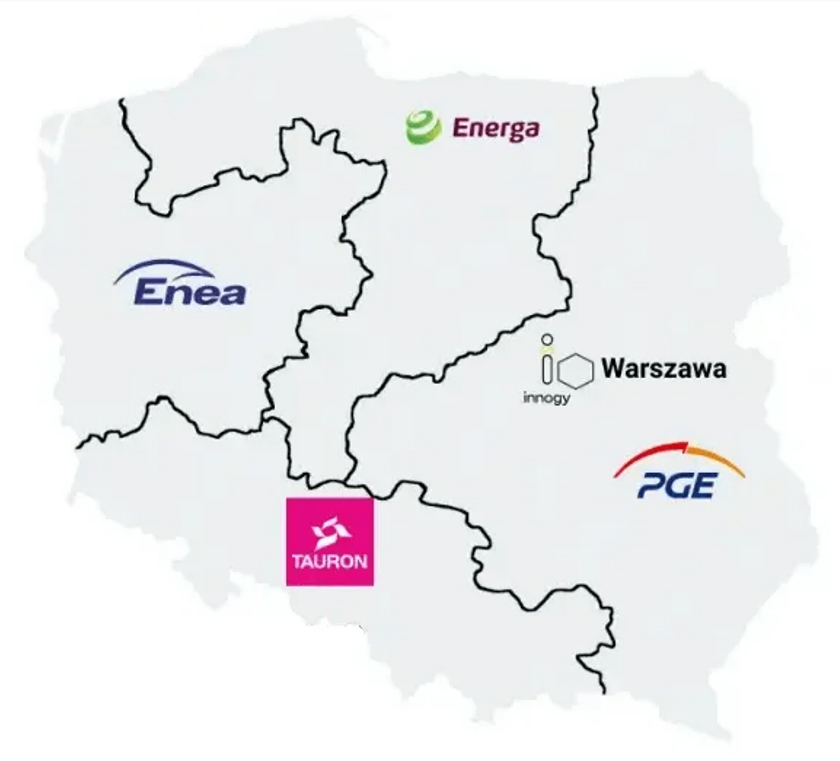
3.3. Identification of the Determinants of Solar Development in Poland
4. Discussion
5. Conclusions
Author Contributions
Funding
Institutional Review Board Statement
Informed Consent Statement
Data Availability Statement
Acknowledgments
Conflicts of Interest
References
- Matláry, J.H. The Development of Energy Policy in the European Union. In Energy Policy in the European Union; The European Union Series; Palgrave: London, UK, 1997; pp. 12–24. [Google Scholar] [CrossRef]
- Bielski, S.; Marks-Bielska, R.; Zielińska-Chmielewska, A.; Romaneckas, K.; Šarauskis, E. Importance of Agriculture in Creating Energy Security—A Case Study of Poland. Energies 2021, 14, 2465. [Google Scholar] [CrossRef]
- Bielski, S.; Zielińska-Chmielewska, A.; Marks-Bielska, R. Use of Environmental Management Systems and Renewable Energy Sources in Selected Food Processing Enterprises in Poland. Energies 2021, 14, 3212. [Google Scholar] [CrossRef]
- Obwieszczenie Ministra Gospodarki z dnia 21 Grudnia 2009 r. w Sprawie Polityki Energetycznej Państwa do 2030 r. (M.P. 2010 nr 2 poz. 11 ). Announcement of the Minister of Economy of 21 December 2009 on the National Energy Policy until 2030 (M. P., 2010 No 2 Item 11). Available online: https://isap.sejm.gov.pl/isap.nsf/download.xsp/WMP20100020011/O/M20100011.pdf (accessed on 20 February 2022). (In Polish)
- Uchwała nr 58 Rady Ministrów z dnia 15 Kwietnia 2014 r. w Sprawie Przyjęcia Strategii “Bezpieczeństwo Energetyczne i Środowisko—perspektywa do 2020 r.” (M.P. z 2014 r., poz. 469). Resolution No. 58 of the Council of Ministers of 15 April 2014 on the Adoption of the Strategy “Energy Security and Environment—Prospect to 2020”. (M.P., 2014, Item 469). Available online: https://isap.sejm.gov.pl/isap.nsf/download.xsp/WMP20140000469/O/M20140469.pdf (accessed on 20 February 2022). (In Polish)
- Obwieszczenie Ministra Klimatu i Środowiska z Dnia 2 Marca 2021 r. w Sprawie Polityki Energetycznej Państwa do 2040 (M.P. z 2021 r., poz. 264). Announcement of the Minister of Climate and Environment of 2 March 2021 on the National Energy Policy until 2040 (M.P., 2021, Item 264). Available online: https://isap.sejm.gov.pl/isap.nsf/download.xsp/WMP20210000264/O/M20210264.pdf (accessed on 20 February 2022). (In Polish)
- Ogarek, P. Przyszłość Odnawialnych Źródeł Energii w Polsce w Oparciu o Politykę Energetyczną Polski do 2040 Roku (The Future of Renewable Energy Sources in Poland Based on Poland’s Energy Policy until 2040). In Bezpieczeństwo Energetyczne Polski i Europy Uwarunkowania—Wyzwania—Innowacje; Ruszel, M., Podmiotko, S., Eds.; Instytut Polityki Energetycznej im. I. Łukasiewicza: Rzeszów, Poland, 2019; pp. 98–119. Available online: https://www.instytutpe.pl/wp-content/uploads/2019/10/Bezpiecze%C5%84stwo-energetyczne-Polski-i-Europy-.pdf (accessed on 31 January 2022). (In Polish)
- Marks-Bielska, R.; Bielski, S.; Pik, K.; Kurowska, K. The importance of renewable energy sources in Poland’s energy mix. Energies 2020, 13, 4624. [Google Scholar] [CrossRef]
- Marks-Bielska, R.; Bielski, S.; Novikova, A.; Romaneckas, K. Straw Stocks as a Source of Renewable Energy. A Case Study of a District in Poland. Sustainability 2019, 11, 4714. [Google Scholar] [CrossRef] [Green Version]
- Mundo-Hernández, J.; de Celis Alonso, B.; Hernández-Álvarez, J.; de Celis-Carrillo, B. An overview of solar photovoltaic energy in Mexico and Germany. Renew. Sustain. Energy Rev. 2014, 31, 639–649. [Google Scholar] [CrossRef]
- Staliński, A. Uwarunkowania prawne i polityczne a konkurencyjność branży elektroenergetycznej OZE w Polsce iw Niemczech. (Legal and political conditions’ influence on the competitiveness of RES production in Poland and Germany). Kwart. Kol. Ekon. Społecznego Studia Pr. 2017, 31, 107–129. (In Polish) [Google Scholar]
- Grau, T.; Huo, M.; Neuhoff, K. Survey of photovoltaic industry and policy in Germany and China. Energy Policy 2012, 51, 20–37. [Google Scholar] [CrossRef] [Green Version]
- Huang, P.; Negro, S.O.; Hekkert, M.P.; Bi, K. How China became a leader in solar PV: An innovation system analysis. Renew. Sustain. Energy Rev. 2016, 64, 777–789. [Google Scholar] [CrossRef] [Green Version]
- Kryszk, H.; Kurowska, K. Fotowoltaika jako źródło energii odnawialnej i nowy obszar aktywności na obszarach wiejskich. (Photovoltaics as a Source of Renewable Energy and a New Area of Activity in Rural Areas). Studia Obsz. Wiej. 2014, 35, 255–272. [Google Scholar]
- Brodny, J.; Tutak, M. Analyzing similarities between the European Union countries in terms of the structure and volume of energy production from renewable energy sources. Energies 2020, 13, 913. [Google Scholar] [CrossRef] [Green Version]
- Halttunen, K.; Staffell, I.; Slade, R.; Green, R.; Saint-Drenan, Y.M.; Jansen, M. Global assessment of the merit-order effect and revenue cannibalisation for variable renewable energy. SSRN 2020. Available online: https://ssrn.com/abstract=3741232 (accessed on 10 February 2022). [CrossRef]
- Cucchiella, F.; Condemi, A.; Rotilio, M.; Annibaldi, V. Energy Transitions in Western European Countries: Regulation Comparative Analysis. Energies 2021, 14, 3940. [Google Scholar] [CrossRef]
- Benghanem, M. Optimization of tilt angle for solar panel: Case study for Madinah, Saudi Arabia. Appl. Energy 2011, 8, 1427–1433. [Google Scholar] [CrossRef]
- Calabrò, E. An algorithm to determine the optimum tilt angle of a solar panel from global horizontal solar radiation. J. Renew. Energy 2013, 2013, 307547. [Google Scholar] [CrossRef] [Green Version]
- Jain, D.; Lalwani, M. A review on optimal inclination angles for solar arrays. Int. J. Renew. Energy Res. 2017, 7, 1053–1061. [Google Scholar] [CrossRef]
- Bahrami, A.; Okoye, C.O.; Atikol, U. The effect of latitude on the performance of different solar trackers in Europe and Africa. Appl. Energy 2016, 177, 896–906. [Google Scholar] [CrossRef]
- Racharla, S.; Rajan, K. Solar tracking system—A review. Int. J. Sustain. Eng. 2017, 10, 72–81. [Google Scholar] [CrossRef]
- Mehdi, G.; Ali, N.; Hussain, S.; Zaidi, A.A.; Shah, A.H.; Azeem, M.M. Design and fabrication of automatic single axis solar tracker for solar panel. In Proceedings of the 2019 2nd International Conference on Computing, Mathematics and Engineering Technologies (ICoMET), Sukkur, Pakistan, 30–31 January 2019; pp. 1–4. [Google Scholar] [CrossRef]
- Koster, D.; Minette, F.; Braun, C.; O’Nagy, O. Short-term and regionalized photovoltaic power forecasting, enhanced by reference systems, on the example of Luxembourg. Renew. Energy 2019, 132, 455–470. [Google Scholar] [CrossRef]
- Hankins, M. Stand-Alone Solar Electric Systems: The Earthscan Expert Handbook for Planning, Design and Installation; Routledge: London, UK, 2010. [Google Scholar] [CrossRef]
- Bollen, M.H.; Rönnberg, S.K. Hosting capacity of the power grid for renewable electricity production and new large consumption equipment. Energies 2017, 10, 1325. [Google Scholar] [CrossRef] [Green Version]
- Bourgain, G. Integrating Distributed Energy Resources in Today’s Electrical Energy System; Book Presenting the Results of the EU-DEEP Project; ExpandDER: Saint Denis le Plaine, France, 2009. [Google Scholar]
- Etherden, N. Increasing the Hosting Capacity of Distributed Energy Resources Using Storage and Communication. Ph.D. Thesis, Luleå University of Technology, Luleå, Sweden, 2014. [Google Scholar]
- Bollen, M.H.J.; Häger, M. Power quality: Interactions between distributed energy resources, the grid and other customers. In Proceedings of the 1st International Conference on Renewable Energy Sources and Distributed Energy Resources, Brussels, Belgium, 1–3 December 2004. [Google Scholar]
- Etherden, N.; Bollen, M.H.J. Increasing the hosting capacity of distribution networks by curtailment of renewable energy resources. In Proceedings of the IEEE Trondheim PowerTech, Trondheim, Norway, 19–23 June 2011. [Google Scholar]
- Currie, B.; Abbey, C.; Ault, G.; Ballard, J.; Conroy, B.; Sims, R.; Williams, C. Flexibility is key in New York: New tools and operational solutions for managing distributed energy resources. IEEE Power Energy Mag. 2017, 15, 20–29. [Google Scholar] [CrossRef]
- Abromas, J. Some Aspects of the Assessment of Visual Impact of Wind Turbines on Landscape of Western Lithuania, in Rural Development 2011. In Proceedings of the Fifth International Scientific Conference, Kaunas, Lithuania, 24–25 November 2011; Volume 1, pp. 298–302. [Google Scholar]
- Ferreira, A.; Kunh, S.S.; Fagnani, K.C.; De Souza, T.A.; Tonezer, C.; Dos Santos, G.R.; Coimbra-Araújo, C.H. Economic overview of the use and production of photovoltaic solar energy in Brazil. Renew. Sustain. Energy Rev. 2018, 81, 181–191. [Google Scholar] [CrossRef]
- Weselek, A.; Ehmann, A.; Zikeli, S.; Lewandowski, I.; Schindele, S.; Högy, P. Agrophotovoltaic systems: Applications, challenges, and opportunities. A review. Agron. Sustain. Dev. 2019, 39, 1–20. [Google Scholar] [CrossRef]
- Kim, S.; Kim, S.; Yoon, C.Y. An efficient structure of an agrophotovoltaic system in a temperate climate region. Agronomy 2021, 11, 1584. [Google Scholar] [CrossRef]
- Mulenga, E.; Bollen, M.H.; Etherden, N. A review of hosting capacity quantification methods for photovoltaics in low-voltage distribution grids. Int. J. Electr. Power Energy Syst. 2020, 115, 105445. [Google Scholar] [CrossRef]
- Stetz, T.; Kraiczy, M.; Diwold, K.; Braun, M.; Bletterie, B.; Mayr, C.; Bründlinger, R.; Noone, B.; Bruce, A.; MacGill, I.; et al. High Penetration PV in Local Distribution Grids Outcomes of the IEA PVPS Task 14 Subtask 2. In Proceedings of the 29th European Photovoltaic Solar Energy Conference and Exhibition, Amsterdam, The Netherlands, 22–26 September 2014; pp. 2176–2183. [Google Scholar]
- Koirala, A.; Van Acker, T.; D’hulst, R.; Van Hertem, D. Hosting capacity of photovoltaic systems in low voltage distribution systems: A benchmark of deterministic and stochastic approaches. Renew. Sustain. Energy Rev. 2022, 155, 111899. [Google Scholar] [CrossRef]
- Haque, M.M.; Wolfs, P. A review of high PV penetrations in LV distribution networks: Present status, impacts and mitigation measures. Renew. Sustain. Energy Rev. 2016, 62, 1195–1208. [Google Scholar] [CrossRef]
- De Oliveira, T.; Carvalho, P.; Ribeiro, P.; Bonatto, B. PV hosting capacity dependence on harmonic voltage distortion in low-voltage grids: Model validation with experimental data. Energies 2018, 11, 465. [Google Scholar] [CrossRef] [Green Version]
- Shayani, R.A.; de Oliveira, M.A.G. Photovoltaic generation penetration limits in radial distribution systems. IEEE Trans. Power Syst. 2011, 26, 1625–1631. [Google Scholar] [CrossRef]
- Luthander, R.; Lingfors, D.; Widén, J. Large-scale integration of photovoltaic power in a distribution grid using power curtailment and energy storage. Sol. Energy 2017, 155, 1319–1325. [Google Scholar] [CrossRef]
- The Act of 19 August 2011 Amending the Energy Law and Other Legal Acts (Journal of Laws 205, Item 1208). Available online: https://isap.sejm.gov.pl/isap.nsf/download.xsp/WDU20112051208/O/D20111208.pdf (accessed on 20 February 2022).
- Available online: https://optimalenergy.pl/dystrybutorzy-zmiana-sprzedawcy-energii/ (accessed on 20 February 2022).
- Szczerbowski, R.; Ceran, B. Polityka energetyczna Polski w aspekcie wyzwań XXI wieku. (Poland’s Energy Policy in the aspect of the challenges of the 21st century). Polityka Energetyczna 2017, 20, 17–28. (In Polish) [Google Scholar]
- Strupeit, L.; Palm, A. Overcoming barriers to renewable energy diffusion: Business models for customer-sited solar photovoltaics in Japan, Germany and the United States. J. Clean. Prod. 2016, 123, 124–136. [Google Scholar] [CrossRef]
- Act of 27 March 2003 on Spatial Planning and Land Management; Journal of Laws, 2021, Item 741, as Amended. Available online: https://isap.sejm.gov.pl/isap.nsf/download.xsp/WDU20030800717/U/D20030717Lj.pdf (accessed on 20 February 2022).
- Available online: https://www.instalacjebudowlane.pl/4011-77-12394-warunki-naslonecznienia-polski-a-kolektory.html (accessed on 26 March 2022).
- Fatima, S.; Püvi, V.; Lehtonen, M. Review on the PV hosting capacity in distribution networks. Energies 2020, 13, 4756. [Google Scholar] [CrossRef]
- Liu, Y.J.; Tai, Y.H.; Huang, C.Y.; Su, H.J.; Lan, P.H.; Hsieh, M.K. Assessment of the PV hosting capacity for the medium-voltage 11.4 kV distribution feeder. In Proceedings of the 4th IEEE International Conference Applied System Innovation 2018, ICASI 2018, Tokyo, Japan, 13–17 April 2018; pp. 381–384. [Google Scholar]
- Kikuchi, S.; Machida, M.; Tamura, J.; Imanaka, M.; Baba, J.; Iioka, D.; Miura, K.; Takagi, M.; Asano, H. Hosting capacity analysis of many distributed photovoltaic systems in future distribution networks. In Proceedings of the 2017 IEEE Innovative Smart Grid Technologies–Asia Smart Grid Smart Community, ISGT-Asia 2017, Auckland, New Zealand, 4–7 December 2017; pp. 1–5. [Google Scholar]
- Smith, J.W.; Dugan, R.; Sunderman, W. Distribution modeling and analysis of high penetration PV. In Proceedings of the IEEE Power and Energy Society General Meeting, Detroit, MI, USA, 24–28 July 2011; pp. 1–7. [Google Scholar]
- Smith, J.W.; Dugan, R.; Rylander, M.; Key, T. Advanced distribution planning tools for high penetration PV deployment. In Proceedings of the IEEE Power and Energy Society General Meeting, San Diego, CA, USA, 22–26 July 2012; pp. 1–7. [Google Scholar]
- Heilscher, G.; Ebe, F.; Idlbi, B.; Morris, J.; Meier, F. Evaluation of PV Hosting Capacities of Distribution Grids with Utilization of Solar-Roof-Potential-Analyses. In Proceedings of the International Conference on Electricity Distribution, Glasgow, UK, 12–15 June 2017; pp. 12–15. [Google Scholar]
- Kaygusuz, K.; Yüksek, Ö.; Sari, A. Renewable energy sources in the European Union: Markets and capacity. Energy Sources Part B Econ. Plann. Policy 2007, 2, 19–29. [Google Scholar] [CrossRef]
- Rataj, M.; Berniak-Woźny, J.; Plebańska, M. Poland as the EU Leader in Terms of Photovoltaic Market Growth Dynamics—Behind the Scenes. Energies 2021, 14, 6987. [Google Scholar] [CrossRef]
- Dujardin, J.; Kahl, A.; Kruyt, B.; Bartlett, S.; Lehning, M. Interplay between photovoltaic, wind energy and storage hydropower in a fully renewable Switzerland. Energy 2017, 135, 513–525. [Google Scholar] [CrossRef]
- Pacesila, M.; Burcea, S.G.; Colesca, S.E. Analysis of renewable energies in European Union. Renew. Sustain. Energy Rev. 2016, 56, 156–170. [Google Scholar] [CrossRef]
- Olkuski, T.; Grudziński, Z. Polityka energetyczna Polski—Nowe wyzwania. (Polish energy policy—New challenges). Zeszyty Naukowe Instytutu Gospodarki Surowcami Mineralnymi Energią PAN 2019, 108, 71–82. (In Polish) [Google Scholar] [CrossRef]
- Rediske, G.; Siluk, J.C.M.; Michels, L.; Rigo, P.D.; Rosa, C.B.; Cugler, G. Multi-criteria decision-making model for assessment of large photovoltaic farms in Brazil. Energy 2020, 197, 117167. [Google Scholar] [CrossRef]
- Valkila, N.; Saari, A. Urgent need for new approach to energy policy: The case of Finland. Renew. Sustain. Energy Rev. 2010, 14, 2068–2076. [Google Scholar] [CrossRef]
- Byrnes, L.; Brown, C.; Foster, J.; Wagner, L.D. Australian renewable energy policy: Barriers and challenges. Renew. Energy 2013, 60, 711–721. [Google Scholar] [CrossRef]
- Allcott, H.; Mullainathan, S.; Taubinsky, D. Energy policy with externalities and internalities. J. Public Econ. 2014, 112, 72–88. [Google Scholar] [CrossRef]
- Da Silva, P.P.; Dantas, G.; Pereira, G.I.; Câmara, L.; De Castro, N.J. Photovoltaic distributed generation–An international review on diffusion, support policies, and electricity sector regulatory adaptation. Renew. Sustain. Energy Rev. 2019, 103, 30–39. [Google Scholar] [CrossRef]
- Jo, B.K.; Jang, G. An evaluation of the effect on the expansion of photovoltaic power generation according to renewable energy certificates on energy storage systems: A case study of the Korean renewable energy market. Sustainability 2019, 11, 4337. [Google Scholar] [CrossRef] [Green Version]
- Narodzonek, A. Umowa dzierżawy nieruchomości gruntowej zawierana w związku z budową farmy fotowoltaicznej. (Land property lease agreement concluded in connection with the construction of a photovoltaic farm). Zeszyt Prawniczy UAM 2021, 11, 217–231. Available online: https://hdl.handle.net/10593/26523 (accessed on 10 February 2022).
- Di Dio, V.; Favuzza, S.; La Cascia, D.; Massaro, F.; Zizzo, G. Critical assessment of support for the evolution of photovoltaics and feed-in tariff(s) in Italy. Sustain. Energy Technol. Assess. 2015, 9, 95–104. [Google Scholar] [CrossRef]
- Moosavian, S.M.; Rahim, N.A.; Selvaraj, J.; Solangi, K.H. Energy policy to promote photovoltaic generation. Renew. Sustain. Energy Rev. 2013, 25, 44–58. [Google Scholar] [CrossRef]
- Piasecka, I.; Bałdowska-Witos, P.; Piotrowska, K.; Kruszelnicka, W.; Flizikowski, J.; Tomporowski, A.D. Ekologiczna analiza cyklu życia farmy fotowoltaicznej o mocy 1 MW w polskich warunkach środowiskowych. (Ecological life cycle assessment of the 1 MW photovoltaic power plant under Polish environmental conditions). Przemysł Chemiczny 2021, 100, 40–46. [Google Scholar] [CrossRef]
- Ibrahim, I.A.; Hossain, M.J. The technical, operational and energy policy issues for developing photovoltaic systems: A review. In Proceedings of the 2018 IEEE Region Ten Symposium (Tensymp), Sydney, Australia, 4–6 July 2018; pp. 100–105. [Google Scholar] [CrossRef]
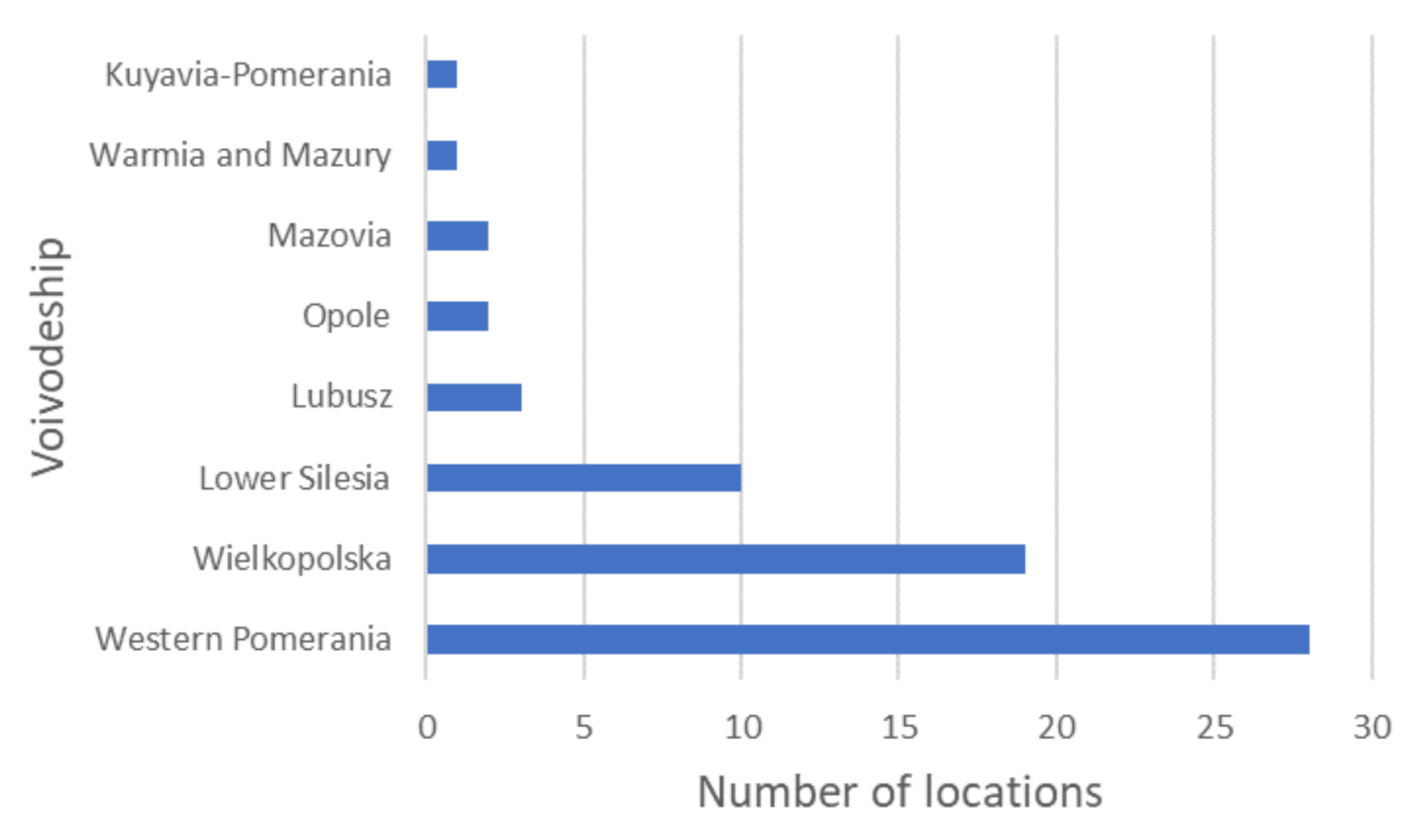
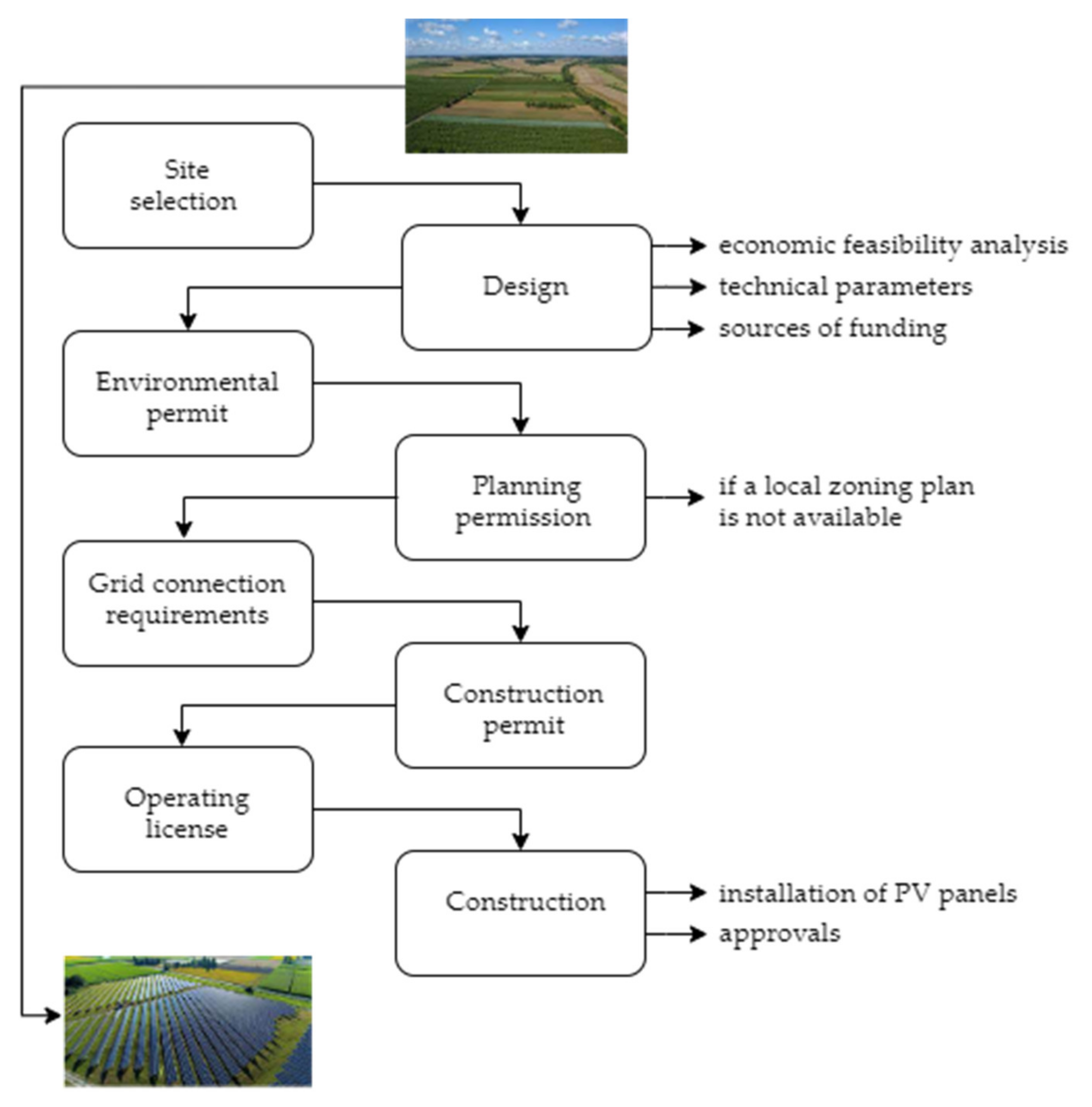
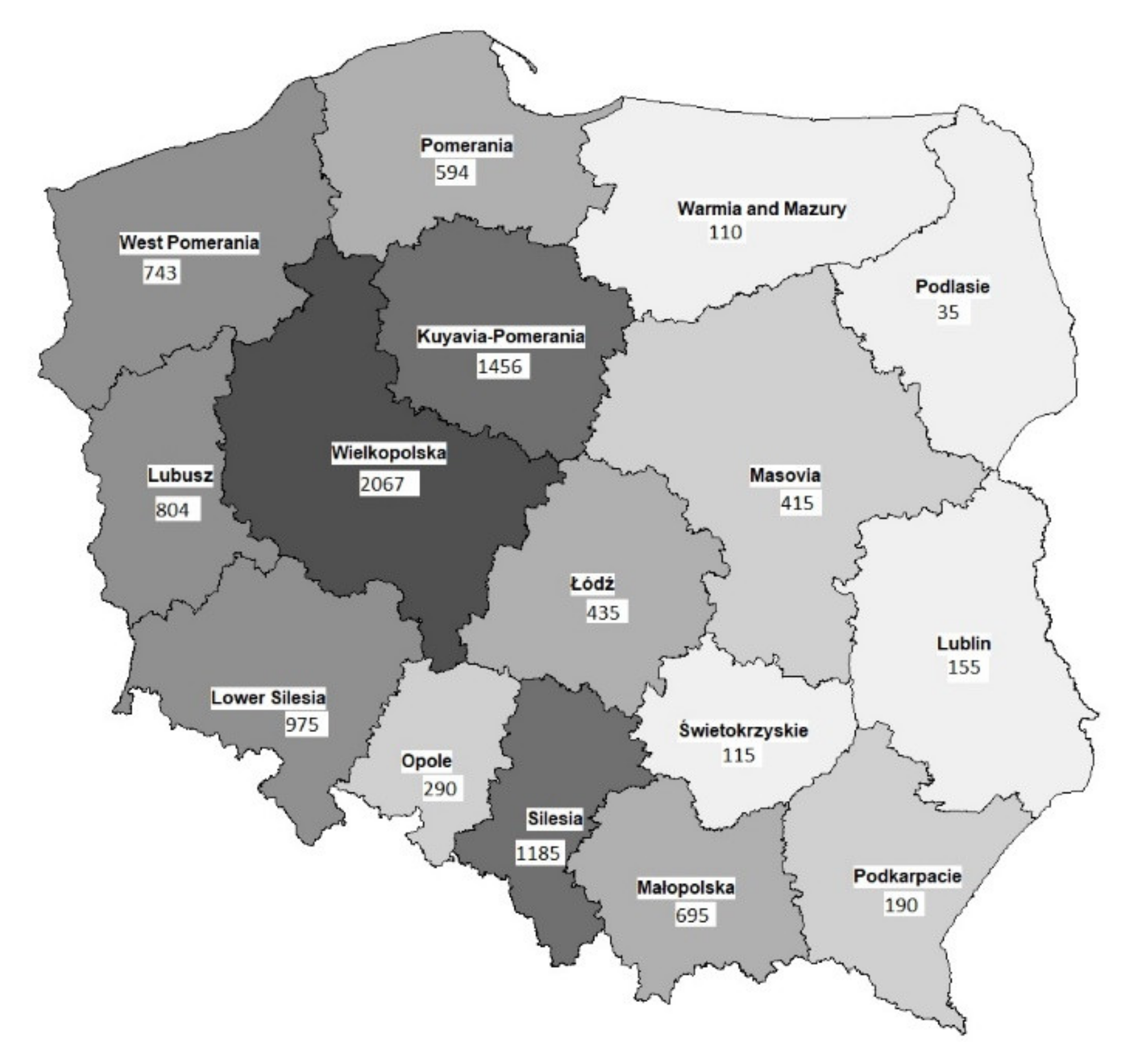
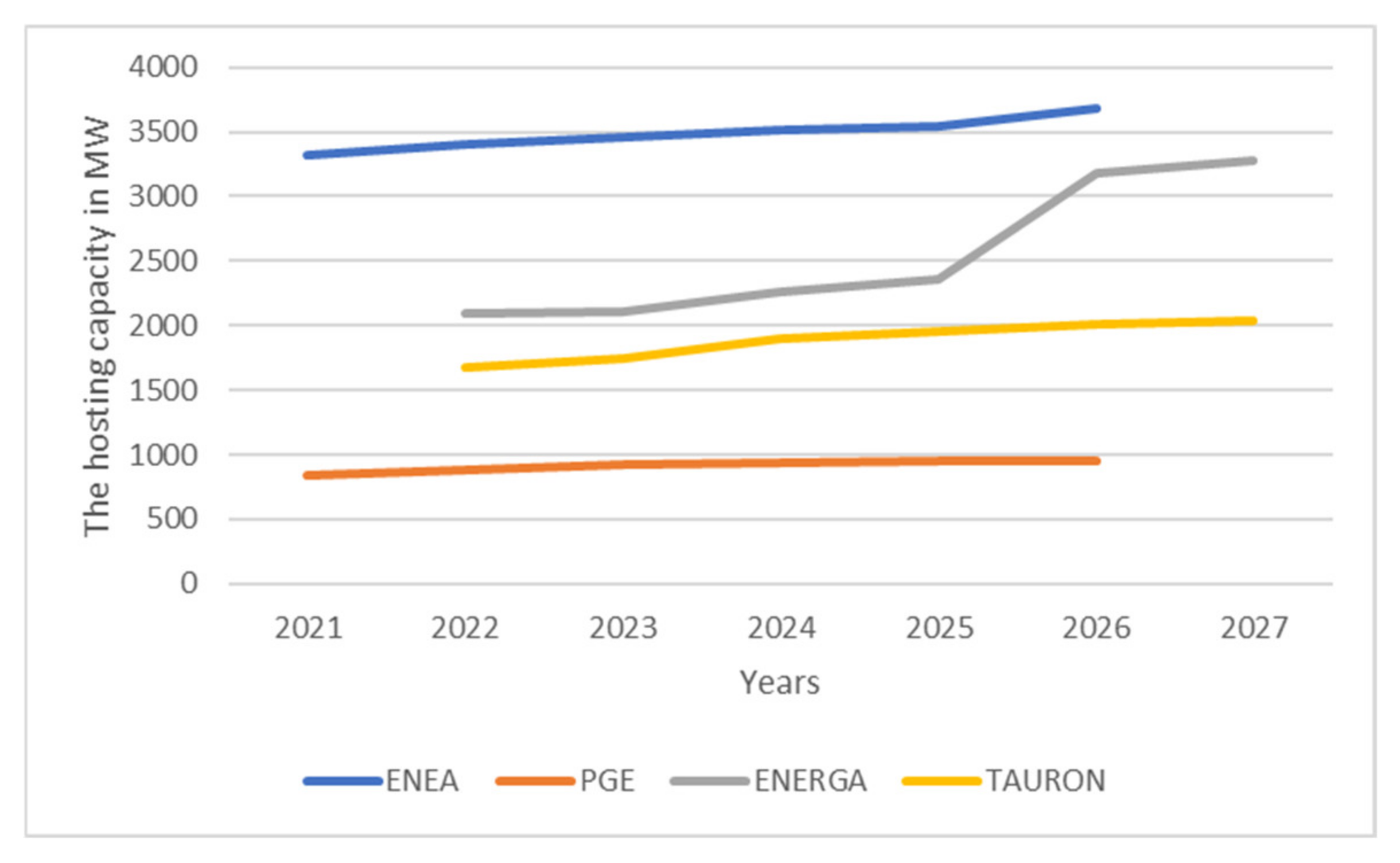
| Specification | Characteristics/ Number of Projects | Characteristics/ Number of Projects |
|---|---|---|
| Predicted power | up to 1 MW/90 | up to 50 MW/5 |
| Zoning classification | zoning plan/0 | individual planning permit/95 |
| Distance to a medium-voltage line | on a parcel/40 | up to 500 m/16 above 500 m/39 |
| Protected areas | none/89 | in the vicinity/6 |
| Landform | favorable/95 | unfavorable/0 |
| Plot shape | regular/35 | irregular/60 |
| Access to a paved road | direct access/77 | must be provided/18 |
| Construction permit | yes/86 | no/9 |
| Solar exposure | up to 1000 kWh/m2/76 | >1000 kWh/m2/19 |
Publisher’s Note: MDPI stays neutral with regard to jurisdictional claims in published maps and institutional affiliations. |
© 2022 by the authors. Licensee MDPI, Basel, Switzerland. This article is an open access article distributed under the terms and conditions of the Creative Commons Attribution (CC BY) license (https://creativecommons.org/licenses/by/4.0/).
Share and Cite
Kurowska, K.; Kryszk, H.; Bielski, S. Location and Technical Requirements for Photovoltaic Power Stations in Poland. Energies 2022, 15, 2701. https://doi.org/10.3390/en15072701
Kurowska K, Kryszk H, Bielski S. Location and Technical Requirements for Photovoltaic Power Stations in Poland. Energies. 2022; 15(7):2701. https://doi.org/10.3390/en15072701
Chicago/Turabian StyleKurowska, Krystyna, Hubert Kryszk, and Stanisław Bielski. 2022. "Location and Technical Requirements for Photovoltaic Power Stations in Poland" Energies 15, no. 7: 2701. https://doi.org/10.3390/en15072701
APA StyleKurowska, K., Kryszk, H., & Bielski, S. (2022). Location and Technical Requirements for Photovoltaic Power Stations in Poland. Energies, 15(7), 2701. https://doi.org/10.3390/en15072701








